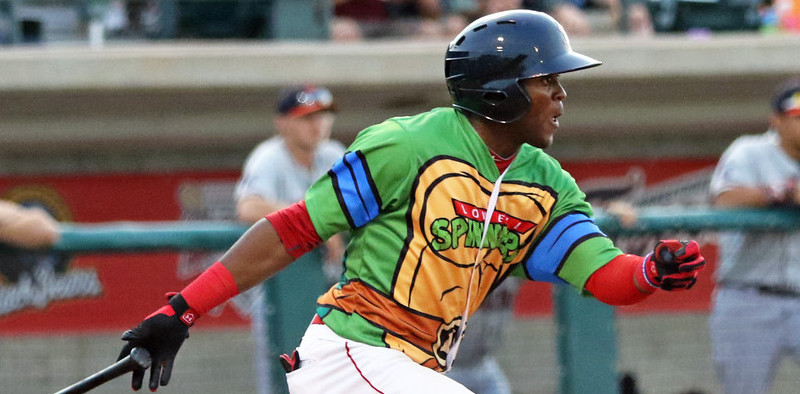Welcome to BP Boston’s Roster Recap series! We continue to break down every player on Boston’s 40-man roster and many of the top prospects in order to provide a comprehensive overview of the roster’s strengths and weaknesses, as well as what we can expect moving forward. There’s no better time than the offseason to review the best (there was some best!) and worst (there was a lot of worst!) of the past year in red and navy. You can see previous editions of Roster Recap here.
In August 2012, the Red Sox signed Luis Basabe as an international amateur free agent out of Venezuela for $450,000, along with fellow amateur Luis Basabe. Okay, that was confusing. Luis Alexander Basabe was signed as an international amateur free agent out of Venezuela for $450,000, along with his twin brother, Luis Alejandro Basabe. That’s right, his parents had twins and named them both Luis Basabe.
For a couple years, that was the most interesting fact about either Basabe brother, as both sort of toiled in the DSL and GCL after signing. Alexander took a step ahead of Alejandro in 2014, particularly in the Dominican League, where he put up an .887 OPS before being sent stateside. He was given another promotion prior to the 2015 season, getting a chance to compete against New York Penn League competition in Lowell. It was there that he really showed off the strong — but raw — tools he possesses.
What Went Right in 2015
Although Basabe’s numbers in Lowell don’t jump out like, say, Andrew Benintendi’s, it was a solid year of initial exposure to stateside baseball for the young outfielder. As an 18-year-old in a league full of former college players, Basabe more than held his own and showed why many evaluators are excited about his potential. Excited enough, it turns out, to be ranked as a top-six prospect in BP’s Red Sox list on Tuesday.
In particular, Basabe’s power potential was something that truly stood out in his time as a Spinner. Again, the numbers don’t tell the whole story in this case. Although he only finished with a .158 ISO, many observers who saw him believe there is bigger potential in his bat. As someone who saw Basabe a bunch this summer, I can confirm that the ball flies off his bat when he makes contact. Even better, he can hit from either side of the plate.
Basabe also showed off some impressive patience for someone his age. Now, some of this is skewed by the low quality of pitchers in the short-season levels of the minors, but he’s been able to maintain double-digit walk rates at every stop in his, admittedly, young career.
Most importantly, the teenager showed everyone the kind of superior athlete he is. Basabe’s speed was on display both on the base paths and in the field. He’s obviously going to need to develop more feel for the game as he ascends through the minors to reach his peak, but Basabe is certainly the kind of athlete who can be a plus defender in center field while also threatening to swipe 20-plus bags a year.
What Went Wrong in 2015
As you might have guessed from all the talk of raw tools above, Basabe also proved to be a little rough around the edges in 2015. While the walk rate was great, he had trouble making steady contact due to an inconsistent approach and a relatively long swing. This is the type of issue that leads to a 26 percent strikeout rate and a .243 AVG in the NYPL, and, more importantly, the type of weakness that can be exposed against stiffer competition higher up in the minors.
More generally, Basabe struggled to find any consistency through the year. There are days when he looks like a clear top-100 prospect, such as his two multi-homer games over a one-week span in early July. Unfortunately, there are also stretches where he looks like a career minor-leaguer, such as his five games with at least three strikeouts. While the tools are clearly there, Basabe’s future would be a lot easier to buy into if he was able to succeed more regularly at a level that has propelled many prospects before him.
Future Outlook/MLB ETA
What’s important to remember is that Basabe is still far from the big leagues in terms of both level and development. He’s yet to make his full-season debut — something he’s likely to do in 2016 — so we have no idea how he’ll hold up over five or six months of playing against better opposition. Assuming he begins the year in Greenville, he’ll again be one of the youngest players at the level and will be facing off against more advanced pitchers than he’s ever seen.
If Basabe can adjust to that competition, there will be even more optimism that he can reach his ceiling of a first-division center fielder with a potent power/speed combination. As fun as it is to dream, he’s more likely at this point to end up as a second-division starter who could have some contact problems but can carry most of his weight with the glove.
As for when we’ll see him in Boston? Any time before 2019 is likely out of the question, and a slow adjustment period this year could push that ETA back to 2020.
Photo by Kelly O’Connor/www.sittingstill.smugmug.com
